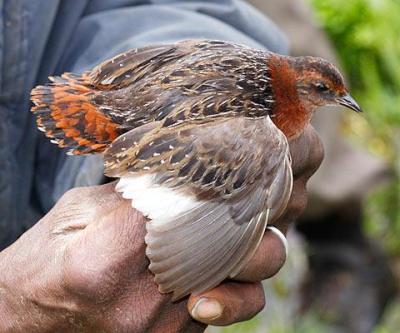ENDANGERED SPECIES OF THE LATEST IUCN RED LIST
5
WINNERS AND LOSERS ON NEW “RED LIST” OF WORLD’S RAREST SPECIES:
IUCN in Switzerland is a guide line to
the world’s rarest species of animals maintained by the International Union for
Conservation of Nature (IUCN). The Red List released on November 25, has more
surprises this year starting from Sea Turtles to Forest Giraffes. It has a
combination of good and bad news for the animal enthusiasts. The happy news is
that Leatherback sea turtles are showing increase in their population particularly
in the Atlantic Ocean. But the shocking news is that the Okapi, a very rarely
seen mammal living in the thickly vegetated habitat in central Africa is in the
brink of extinction.
1. OKAPI:- (new to the list)
Also called as the forest giraffe, is on the brink of extinction. It was not discovered until the 20th century. It is a mammal that lives deep in the heart of the forest of Democratic Republic of the Congo. The stripes on its body remind us of a Zebra, but it is much more closely related to the Giraffe. The okapi is so rarely seen that it’s sometimes likened to a unicorn. When counted, it was shocking to see that the number of Okapi’s have gone down due to armed conflict and encroachment on reserves like Virunga National Park. It is mainly hunted for its meat and skin.
Also called as the forest giraffe, is on the brink of extinction. It was not discovered until the 20th century. It is a mammal that lives deep in the heart of the forest of Democratic Republic of the Congo. The stripes on its body remind us of a Zebra, but it is much more closely related to the Giraffe. The okapi is so rarely seen that it’s sometimes likened to a unicorn. When counted, it was shocking to see that the number of Okapi’s have gone down due to armed conflict and encroachment on reserves like Virunga National Park. It is mainly hunted for its meat and skin.
 2. LEATHERBACK SEA TURTLES:- (recovers) These
turtles are considered to be the largest living turtles, reaching up to 1,500
pounds/individual turtle. The number of turtles has been declining in the
Pacific Ocean over the years, but their numbers have increased in the Atlantic
Ocean. It is due to the greater care taken to preserve these special creatures
nesting beaches, more regulations on fishing, and better fishing gear, and a
crackdown on egg poachers.
2. LEATHERBACK SEA TURTLES:- (recovers) These
turtles are considered to be the largest living turtles, reaching up to 1,500
pounds/individual turtle. The number of turtles has been declining in the
Pacific Ocean over the years, but their numbers have increased in the Atlantic
Ocean. It is due to the greater care taken to preserve these special creatures
nesting beaches, more regulations on fishing, and better fishing gear, and a
crackdown on egg poachers.
3.
ULTRARARE WHITE-WINGED FLUFFTAILS:- (fewer than 1,000 left)
 These
white-winged fluffailed very secretive birds live in the wetlands, migrating to
higher heights for reproduction. They have dove-sized bodies,with white wing
patches and graying chestnut coloring over the rest of the body. It is mostly
found in Ethiopia, South Africa and Zimbabwe. Only 700 breeding-age flufftails
have been counted recently, this is because the wetlands are treated as waste
areas that are drained and developed into other constructions. Ultimately the bird’s
habitat is left under huge treat and it is pushing the birds into extinction.
These
white-winged fluffailed very secretive birds live in the wetlands, migrating to
higher heights for reproduction. They have dove-sized bodies,with white wing
patches and graying chestnut coloring over the rest of the body. It is mostly
found in Ethiopia, South Africa and Zimbabwe. Only 700 breeding-age flufftails
have been counted recently, this is because the wetlands are treated as waste
areas that are drained and developed into other constructions. Ultimately the bird’s
habitat is left under huge treat and it is pushing the birds into extinction. 4.
A CALIFORNIA FOX:- (rebounds)A few years ago the
California Fox was in quick decline, down to only 1,500 individuals. It was due
to the predators like the golden eagles and rats, that ate them or spread
disease to them. But now the National Park Service has removed the eagles, and
reintroduced foxes, and saved them from certain diseases by inoculating them.
Now they have 5,500 foxes in the park.
4.
A CALIFORNIA FOX:- (rebounds)A few years ago the
California Fox was in quick decline, down to only 1,500 individuals. It was due
to the predators like the golden eagles and rats, that ate them or spread
disease to them. But now the National Park Service has removed the eagles, and
reintroduced foxes, and saved them from certain diseases by inoculating them.
Now they have 5,500 foxes in the park. 5. ALBATROSS:- (Ups and downs) These are large birds
that travel long distances around the world. They spend most of their lives
flying above the great Oceans using their broad wings. In an overall survey the
Albatrosses are in a very bad condition. But there are some positive signs of
recovery too. Their numbers have declined in recent years, mainly due to human
activity like fishing which inversely decreases the bird’s food supply. For now
there are only 1.1 – 1.4 million mature black-browed albatrosses and 129,000
mature black-footed albatrosses.
5. ALBATROSS:- (Ups and downs) These are large birds
that travel long distances around the world. They spend most of their lives
flying above the great Oceans using their broad wings. In an overall survey the
Albatrosses are in a very bad condition. But there are some positive signs of
recovery too. Their numbers have declined in recent years, mainly due to human
activity like fishing which inversely decreases the bird’s food supply. For now
there are only 1.1 – 1.4 million mature black-browed albatrosses and 129,000
mature black-footed albatrosses.




